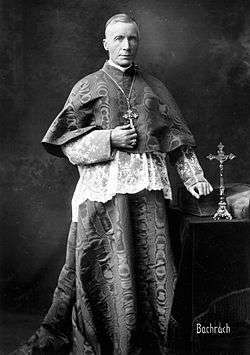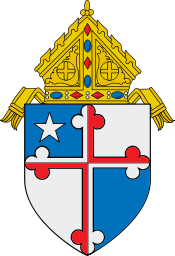St. Mary's Seminary and University
 | |
| Motto | Apostolica civilisque (Latin) |
|---|---|
Motto in English | Apostolic and public |
| Type | Roman Catholic seminary |
| Established | 1791 (225 years ago) |
| Affiliation |
Roman Catholic Church (Sulpician Fathers) |
| President Rector | Rev. Phillip J. Brown, S.S., J.D., S.T.B., J.C.D, J.C.L. |
| Students | 294 |
| Location |
Baltimore, Maryland, United States 39°21′37″N 76°38′24″W / 39.3604°N 76.6400°WCoordinates: 39°21′37″N 76°38′24″W / 39.3604°N 76.6400°W |
| Campus | 40 acres (16 ha) |
| Website | www.stmarys.edu |
St. Mary's Seminary and University is a Roman Catholic seminary located within the Archdiocese of Baltimore in Baltimore, Maryland; it was the first seminary founded in the United States of America after the Revolution.
History
Founded in 1791 as a Catholic seminary under the leadership of newly ordained first Bishop John Carroll, (1735-1815), after he returned to America from his consecration in England that year. A former large tavern was secured just northwest outside of the growing Baltimore Town on the Hookstown Road (which later became known as Pennsylvania Avenue in the Upton neighborhood, the main Afro-American/Black commercial and entertainment district in the early 20th Century). Within a decade, the Seminary was moved south to North Paca Street at the developed northwest edge of the newly incorporated city. St. Mary's was additionally chartered as a civil college by the State of Maryland in 1805 (1806?) and was operated until 1852 by the Sulpicians religious order and graduated hundreds of young men and formed an important educational role in the growing city during the first half of the 19th Century. The under-graduate College was later closed and replaced in the same year by the opening of Loyola College and Loyola High School by the Jesuits (Society of Jesus) in two small rented townhouses on Holliday Street, between East Lexington and East Fayette Streets - the site, two decades later in the future, across from the massive new second Baltimore City Hall of 1867-1875, now the site of the War Memorial Plaza). St. Mary's was established as a seminary in 1822 by Pope Pius VII, when it was authorized as the first ecclesiastical faculty in the United States with the right to grant degrees in the name of the Holy See.[1] The seminary was founded by the French Sulpician Fathers, and continued to be operated by that Community after 1852.
Designed in 1806 by J. Maximilian M. Godefroy, a renowned émigré French architect, (who also had just designed the famous iconic "Battle Monument" (from the recent War of 1812, commemorating the casualties of soldiers and officers from the previous British military attack in the Battle of Baltimore, with the bombardment of Fort McHenry, Battle of North Point, and stand-off at the eastern city fortifications at Loudenschlager's Hill (now Hampstead Hill in Patterson Park, September 12-13-14, 1814) at the old former Baltimore County/Town Courthouse Square on North Calvert Street between East Lexington and East Fayette Streets - constructed 1815 to 1822, and the now landmark First Independent Church of Baltimore (later to become known as the First Unitarian Church of Baltimore (Unitarian and Universalist) at West Franklin and North Charles Streets - 1817). Godefroy's original chapel stands adjacent to the now historical shrine of the "Mother Seton House", used by Elizabeth Ann Seton, (1774-1821), (first elevated Roman Catholic saint in America). It is the only part of the first group of original seminary/college buildings in Georgian/Federal red brick style from the 1810s which were later razed and a second set of Seminary buildings in a Victorian/French Second Empire style of architecture were erected on the same site facing east on North Paca Street in 1878 and surrounded the original Chapel that is remaining on Paca facing west, into the 21st Century. The old Godefroy Chapel is now used as part of the seminary's Spiritual Center. St. Elizabeth Ann Seton, lived at the nearby house while she was briefly living in Baltimore during 1806 to 1809; it was later named for her and now contains some historical and biographical exhibits on her life and work.[1] The influence of the St. Mary's Seminary increased in the late 19th Century under the leadership of Alphonse Magnien, who served as superior of the school from 1878 to 1902.
St. Mary's Seminary and now University moved to a large 40-acre, park-like campus at the southwest intersection of Roland and Belvedere (later Northern Parkway) Avenues in the Roland Park section of northern Baltimore City in 1929, with the construction of its present Beaux ArtsClassical Revival style, central main building, designed by the firm of Maginnis and Walsh of Boston, which is set far back to the west from Roland Avenue across a great grass lawn. The lawn was used as a helicopter pad for leaving to the local airport following the several days of the 1995 Baltimore visit by Pope John Paul II.[1][2]
In 1968, reflecting a more ecumenical and outgoing spirit from the Second Vatican Council and with educational partnerships with neighboring Christian traditions/denominations of (Protestant and Eastern Orthodox) in the City and central Maryland region, plus having additional space and resources due to a decline in the number of priests in formation by the late 1960s, an "Ecumenical Institute of Theology" was established in 1968 with a separate board of trustees of lay and clergy members from the Catholic and other partnering faiths and a separate dean/director and began offering courses, programs, events with library resources and religious training on a graduate-level to the laity and clergy of the area, which has since greatly raised the academic levels and religious discourse in the following four decades.
In 1974, the institution's name was changed to "St. Mary's Seminary and University" to reflect its expanded departments and graduate degree programs.[2]
During his famous visit to the "Premier See" of Baltimore in 1995, the first by any "Bishop of Rome", Pope John Paul II, visited briefly and prayed at the Seminary Chapel and used the spacious front lawn to lift off in his papal helicopter ending his tour of the Archdiocese and its City.
Father Robert F. Leavitt retired as long-time president/rector in spring 2007, having served at that position for 27 years—the longest tenure of any president/rector in the School's history. The Seminary's alumni have gone on to reach bishop's positions and form leading teaching roles in various theological seminaries of the Church in many cities and towns of the United States.
Institutes and facilities
The Knott Library (endowed by industrialist, contractor/builder, and philanthropist Henry J. Knott) at St. Mary's Seminary and University houses the collected papers of Fr. Raymond E. Brown S.S. (S.T.B., 1951), an eminent Johannine scholar and St. Mary's graduate.[3]
The Ecumenical Institute of Theology at St. Mary's, founded in 1968, offers graduate degrees and certificates; it supports a diverse adult learning environment of different ethnicities and denominations. Dr. Brent Laytham, formerly of North Park University, is the E.I.'s dean, succeeding Dr. Michael J. Gorman.[4] Gorman remains on the faculty as the inaugural Raymond E. Brown Professor of Biblical Studies and Theology.
In May 2012, N. T. Wright was the keynote speaker for the graduating class at the E.I. and was himself awarded an honorary degree.
Notable alumni

- William O. Brady, (1899–1961), Archbishop of Saint Paul and Minneapolis, in St. Paul, Minnesota
- Raymond E. Brown, (1928-1998), biblical/theological scholar of the Sulpician Fathers, served at the nominally Protestant-led, famous Union Theological Seminary in New York City
- Edward Mann Butler, (1784–1855), first president of the University of Louisville, in Louisville, Kentucky
- Patrick Joseph Byrne, (1888-1950), Maryknoll Missionary who served as Apostolic Delegate to the Republic of Korea, in Seoul
- James Carroll, (1791–1873), U.S. Representative (Congressman) in the twenty-sixth United States Congress (relative of Bishop John Carroll of the Diocese and later Archdiocese of Baltimore), in Baltimore, Maryland
- Samuel Eccleston, (1801–1851), fifth Archbishop of Baltimore, (1831-1854), Baltimore, Maryland|Baltimore, Maryland
- Terence P. Finnegan, (1904–1990), Chief of Chaplains of the U.S. Air Force, at The Pentagon, U.S. Department of Defense, Washington, D.C.
- John Samuel Foley, (1833–1918), Bishop of Detroit, in Detroit, Michigan
- James Cardinal Gibbons, (1834–1921), ninth Cardinal Archbishop of Baltimore, (1877-1921) in Baltimore, Maryland
- Benjamin Ignatius Hayes, (1815–1877), lawyer, resided in Los Angeles, elected first California District Court Judge of the newly established "First Judicial District of California" from 1852-1864 for the southern California Counties of Los Angeles, San Diego and San Bernardino Counties. Writer/Author about early California province, republic and state history plus legal practices, law and precedents.
- Peter Leo Ireton, (1882–1958), Bishop of Richmond, in Richmond, Virginia
- John Joseph Kain, (1841–1903), Archbishop of Saint Louis, in St. Louis, Missouri
- Edward Kavanagh, (1795–1844), seventeenth Governor of Maine at the State Capitol, in Augusta, Maine
- Cornelius Leary (1813-1893), U.S. Representative in the 37th U.S. Congress
- William Francis Malooly, (born 1944), current Bishop of Wilmington in Wilmington, Delaware
- Thomas Mardaga, (1913–1984), sixth Bishop of Wilmington in Wilmington, Delaware
- William Matthews, (1770–1854), seventh President of Georgetown College and first British-American-born Catholic priest
- Edward Mooney, (1882–1958), Cardinal Archbishop of Detroit, in Detroit, Michigan
- Martin John O'Connor, (1900–1986), bishop and rector of the Pontifical North American College, at Vatican City, in Rome, Italy
- Bernard O'Reilly, (1803–1856), Bishop of Hartford, in Hartford, Connecticut
- Patrick Thomas O'Reilly, (1833–1892), first Bishop of Springfield in Springfield, Massachusetts
- Richard Phelan (1828–1904), Bishop of Pittsburgh in Pittsburgh, Pennsylvania
- Edward Coote Pinkney, (1802–1828), poet, lawyer, sailor, professor, and editor
- John Baptist Pitaval, (1858–1928), Archbishop of Santa Fe in Santa Fe, New Mexico
- Joseph C. Plagens, (1880–1943), Bishop of Grand Rapids in Grand Rapids, Michigan
- Michael Portier, (1795–1859), first Bishop of Mobile in Mobile, Alabama
- Ignatius A. Reynolds, (1798–1855), Bishop of Charleston in Charleston, South Carolina
- John Joyce Russell, (1897–1993), Bishop of Richmond in Richmond, Virginia
- William Thomas Russell, (1863–1927), Bishop of Charleston, in Charleston, South Carolina
- Augustus John Schwertner, (1870–1939), Bishop of Wichita in Wichita, Kansas
- Jerome Sebastian, (1895–1960), Auxiliary Bishop of the Archdiocese of Baltimore in Baltimore, Maryland
- F. Richard Spencer, (born 1951), current auxiliary bishop of the Archdiocese for the Military Services
- Walter Francis Sullivan, (1928-2012), Bishop of Richmond, in Richmond, Virginia
- John Payne Todd (1792–1852), step-son of fourth President James Madison, (1751-1836, served 1809-1817)[5]
- Thomas Joseph Toolen, (1886–1976), Bishop of Mobile in Mobile, Alabama
- Severn Teackle Wallis (1816–1894), noted lawyer, scholar, civic leader in Baltimore, Maryland (ancestor of Wallis Warfield Simpson of Baltimore, future Duchess of Windsor and wife of former King Edward VIII, later Duke of Windsor, who abdicated the British throne in 1937)
- Vincent Stanislaus Waters, (1904–1974), Bishop of Raleigh in Raleigh, North Carolina
- Joseph Clement Willging, (1884–1959), Bishop of Pueblo in Pueblo, Colorado
- David Zubik, (born 1949), current Bishop of Pittsburgh in Pittsburgh, Pennsylvania
See also
References
- 1 2 3 "America's First Seminary". St. Mary's Seminary and University. Retrieved 6 July 2010.
- 1 2 "St. Mary's Seminary & University". BrainTrack. Retrieved 6 July 2010.
- ↑ "Welcome to the Knott Library". St. Mary's Seminary and University. Retrieved 6 July 2010.
- ↑ "The Ecumenical Institute of Theology: An Invitation". St. Mary's University and Seminary. Retrieved 6 July 2010.
- ↑ "John Payne Todd". Find A Grave. Retrieved 5 July 2010.
External links
- Roman Catholic Archdiocese of Baltimore
- St. Mary's Seminary & University
- St. Mary's Spiritual Center & Historic Site
